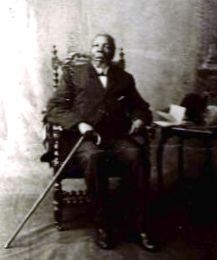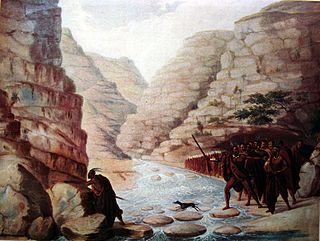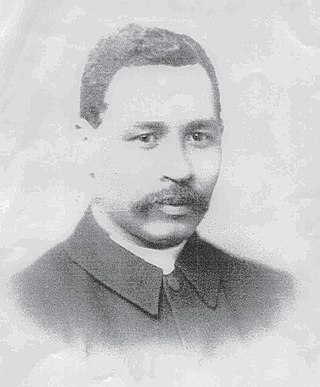
The history of the Cape Colony from 1806 to 1870 spans the period of the history of the Cape Colony during the Cape Frontier Wars, which lasted from 1779 to 1879. The wars were fought between the European colonists and the native Xhosa who, defending their land, fought against European rule.

The amaMfengu were a group of Xhosa clans whose ancestors were refugees that fled from the Mfecane in the early-mid 19th century to seek land and protection from the Xhosa. These refugees were assimilated into the Xhosa nation and were officially recognized by the then king, Hintsa.

Tiyo Soga was a Xhosa journalist, minister, translator, missionary evangelist, and composer of hymns. Soga was the first black South African to be ordained, and worked to translate the Bible and John Bunyan's classic work Pilgrim's Progress into his native Xhosa language.

The Xhosa Wars were a series of nine wars between the Xhosa Kingdom and the British Empire as well as Trekboers in what is now the Eastern Cape in South Africa. These events were the longest-running military resistance against European colonialism in Africa.

William Wellington Gqoba was a South African Xhosa poet, translator, and journalist. He was a major nineteenth-century Xhosa writer, whose relatively short life saw him working as a wagonmaker, a clerk, a teacher, a translator of Xhosa and English, and a pastor.

The Bhaca people, or amaBhaca, are an Nguni ethnic group in South Africa.

Samuel Edward Krune Mqhayi was a Xhosa dramatist, essayist, critic, novelist, historian, biographer, translator and poet whose works are regarded as instrumental in standardising the grammar of isiXhosa and preserving the language in the 20th century.

Dr Johannes Theodorus van der Kemp was a military officer, doctor, and philosopher who became a missionary in South Africa.
The Rharhabe House is the second senior house of the Xhosa Kingdom. Its royal palace is in the former Ciskei and its counterpart in the former Transkei is the Gcaleka, which is the great house of Phalo.

The Ngqika people are a Xhosa monarchy who lived west of the Great Kei River in what is today the Eastern Cape of South Africa. They were first ruled by Rarabe kaPhalo who died with his son Mlawu, who was destined for chieftaincy. The clan would be named after Ngqika ka Mlawu, the son of the then late Mlawu. It would be years before the child would rule his people who fought in the Xhosa Wars, which were sparked by the encroachment of European settlers on Xhosa lands.

Makhanda, also spelled Makana and also known as Nxele, was a Xhosa indigenous doctor. He served as a top advisor to Chief Ndlambe. During the Xhosa Wars, on 22 April 1819, he initiated an abortive assault on the town of Grahamstown, in what was then the Cape Colony.

This article focuses on the history of 19th century Xhosa language newspapers in South Africa.

Coenraad De Buys was described as "a remarkable figure" on the frontier of the Cape Colony. Travellers described him with awe. Their accounts mentioned that he was an impressive figure, nearly seven foot tall and with enormous self-confidence.
Centane, or alternatively anglicised Kentane or Kentani because Europeans often cannot easily pronounce the Xhosa click 'C'; is a settlement in Amathole District Municipality in the Eastern Cape province of South Africa. It is situated at approximately 31 kilometres (19 mi) from Butterworth.
Jotello Festiri Soga was South Africa's first black veterinary surgeon who played a leading role in eradicating rinderpest. The library at the Faculty of Veterinary Science at the University of Pretoria is named for him.
The AmaNdlambe or the Ndlambe is a Xhosa principality located in the Eastern Cape, South Africa. Founded by Prince Ndlambe, son of King Rharhabe and grandson of King Phalo, Ndlambe's advisors and strong army were known as the 'AmaNdlambe'. Prince Ndlambe was also the uncle of King Hintsa.
The Imidushane clan was founded by one of the greatest Xhosa warriors Prince Mdushane who was the eldest son of Prince Ndlambe, the son of King Rharhabe.
The Battle of Amalinda was an armed confrontation between two Xhosa chiefs of the Rharhabe House, which took place in October 1818 just outside of what is today King Williams Town, in the Eastern Cape region of South Africa. On the eve of the fifth Xhosa War Chief Ngqika had close ties with the British, while his uncle, Chief Ndlambe, had no such agreements and painted Ngqika as someone selling out his people in return for personal gain. Chief Ndlambe was assisted in the battle by the senior, King Hintsa and his Gcaleka warriors. When chief Ngqika was defeated in the battle, he retreated and appealed to the British for protection. A British-led force commanded by Colonel Thomas Brereton then seized 23,000 head of cattle from Ndlambe's people in retaliation, leading to the battle of Grahamstown.

William Anderson Soga was the first black African to qualify with an MBCM in 1883 and the first black African medical doctor to practise in South Africa, as well as being the first black African to obtain a doctorate MD. His thesis titled "The ethnology of the Bomvanas of Bomvanaland, an aboriginal tribe in South East Africa, with observations upon the climate and diseases of the country, and the methods of treatment in use among the people" was completed at the University of Glasgow in 1895. He was also ordained as a minister in the United Presbyterian Church 1885 making him one of the first medical missionaries in South Africa. Soga was involved in the running of mission stations, building churches, diagnosis and treatment of patients, research and writing.













